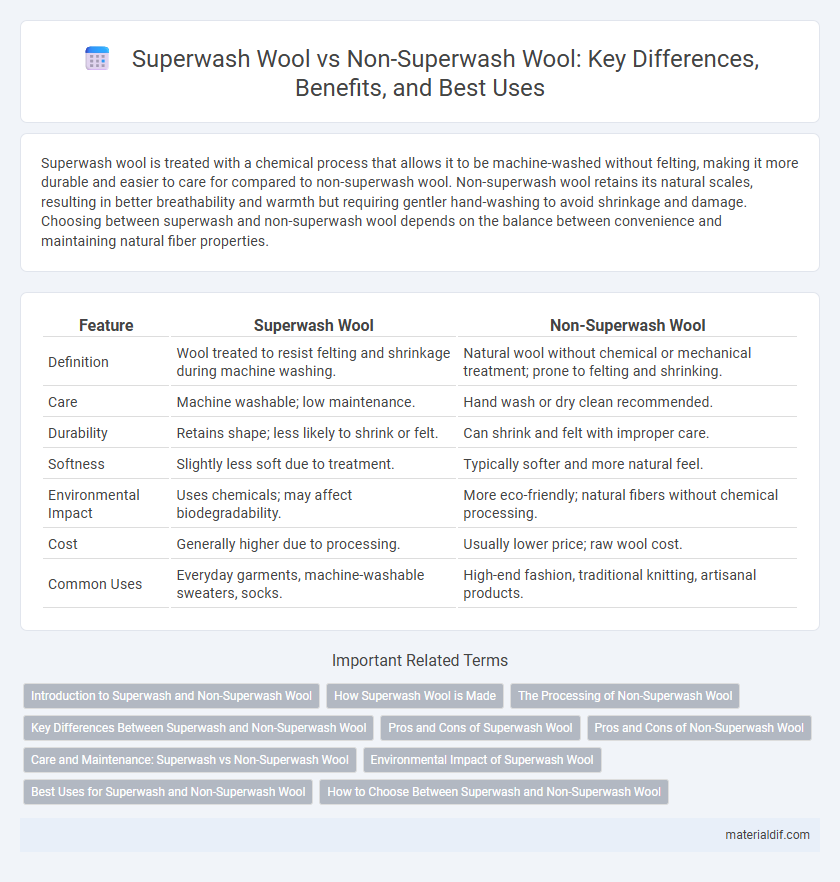Superwash wool is treated with a chemical process that allows it to be machine-washed without felting, making it more durable and easier to care for compared to non-superwash wool. Non-superwash wool retains its natural scales, resulting in better breathability and warmth but requiring gentler hand-washing to avoid shrinkage and damage. Choosing between superwash and non-superwash wool depends on the balance between convenience and maintaining natural fiber properties.
Table of Comparison
| Feature | Superwash Wool | Non-Superwash Wool |
|---|---|---|
| Definition | Wool treated to resist felting and shrinkage during machine washing. | Natural wool without chemical or mechanical treatment; prone to felting and shrinking. |
| Care | Machine washable; low maintenance. | Hand wash or dry clean recommended. |
| Durability | Retains shape; less likely to shrink or felt. | Can shrink and felt with improper care. |
| Softness | Slightly less soft due to treatment. | Typically softer and more natural feel. |
| Environmental Impact | Uses chemicals; may affect biodegradability. | More eco-friendly; natural fibers without chemical processing. |
| Cost | Generally higher due to processing. | Usually lower price; raw wool cost. |
| Common Uses | Everyday garments, machine-washable sweaters, socks. | High-end fashion, traditional knitting, artisanal products. |
Introduction to Superwash and Non-Superwash Wool
Superwash wool undergoes a specialized treatment that removes or coats the scales on wool fibers, preventing felting and allowing machine washing without shrinking. Non-superwash wool retains its natural scales, making it more prone to felting and requiring gentle hand washing. This distinction influences care methods and durability, with superwash wool favored for ease of maintenance and non-superwash prized for its natural texture and breathability.
How Superwash Wool is Made
Superwash wool is made through a proprietary chemical treatment that removes or coats the wool's natural scales, preventing felting and shrinkage during washing. This process typically involves chlorination or polymer coating, allowing the wool fibers to retain softness and durability while becoming machine washable. As a result, superwash wool garments offer enhanced ease of care compared to non-superwash wool, which requires gentle hand washing to maintain fiber integrity.
The Processing of Non-Superwash Wool
Non-superwash wool undergoes minimal processing, retaining its natural scales and lanolin, which contribute to its tactile warmth and breathability but also its tendency to felt and shrink when washed. Unlike superwash wool, it is not treated with chemical or mechanical methods to smooth the fibers, preserving the fiber's natural texture and durability. This traditional processing ensures non-superwash wool is favored for artisanal and high-end products that benefit from wool's inherent protective qualities and rustic appeal.
Key Differences Between Superwash and Non-Superwash Wool
Superwash wool undergoes a chemical or mechanical treatment that removes or coats the scales on wool fibers, making it machine-washable and resistant to felting. Non-superwash wool retains its natural scales, resulting in greater warmth and durability but requiring hand washing to prevent shrinkage and felting. The choice between superwash and non-superwash wool depends on the balance between convenience, fabric care, and maintaining traditional wool characteristics.
Pros and Cons of Superwash Wool
Superwash wool undergoes a chemical treatment that prevents felting and shrinking, making it machine washable and more convenient for everyday wear. However, this treatment can reduce the natural breathability and softness of the wool, sometimes causing it to feel less warm or durable compared to non-superwash wool. Non-superwash wool retains its natural fiber integrity, offering superior insulation and moisture-wicking properties, but requires more delicate care to avoid damage.
Pros and Cons of Non-Superwash Wool
Non-superwash wool retains its natural lanolin, providing superior water resistance and breathability that enhances comfort and temperature regulation. It is more environmentally friendly due to less chemical processing but requires delicate hand washing to prevent felting and shrinkage. This type of wool often has a richer texture and stronger fibers, making it ideal for durable, long-lasting garments despite the extra care needed.
Care and Maintenance: Superwash vs Non-Superwash Wool
Superwash wool undergoes a chemical or mechanical treatment that enables it to be machine-washed without felting, making its care and maintenance simpler and more convenient compared to non-superwash wool. Non-superwash wool requires gentle hand washing or dry cleaning to avoid shrinkage and damage, as it retains its natural scales that cause felting when exposed to agitation or heat. Choosing superwash wool significantly reduces the risk of shrinkage and extends the lifespan of wool garments through easier routine care.
Environmental Impact of Superwash Wool
Superwash wool undergoes chemical treatments, such as chlorination, that strip the wool's natural scales, enabling machine washing but causing significant environmental concerns due to toxic wastewater release and increased chemical usage. Non-superwash wool maintains its natural properties without harsh chemicals, resulting in a lower ecological footprint and more sustainable production practices. Choosing non-superwash wool supports reduced water pollution and preserves soil and aquatic ecosystems compared to superwash wool processing.
Best Uses for Superwash and Non-Superwash Wool
Superwash wool is ideal for everyday garments like socks, sweaters, and baby clothes due to its machine-washable convenience and resistance to felting. Non-superwash wool, known for its natural texture and superior insulation, excels in outdoor apparel, heavy-duty items, and artisanal knitting projects where durability and warmth are prioritized. Choosing between the two depends on the desired care requirements and the wool's end-use performance characteristics.
How to Choose Between Superwash and Non-Superwash Wool
Choosing between superwash and non-superwash wool depends on the intended use and care preferences; superwash wool is treated to be machine washable and less prone to felting, making it ideal for easy maintenance and everyday wear. Non-superwash wool retains its natural fibers, offering superior warmth, durability, and water resistance, but requires gentle hand washing to prevent shrinkage and damage. Consider superwash wool for convenience and non-superwash for natural fiber benefits and traditional wool qualities.
Superwash Wool vs Non-Superwash Wool Infographic

 materialdif.com
materialdif.com